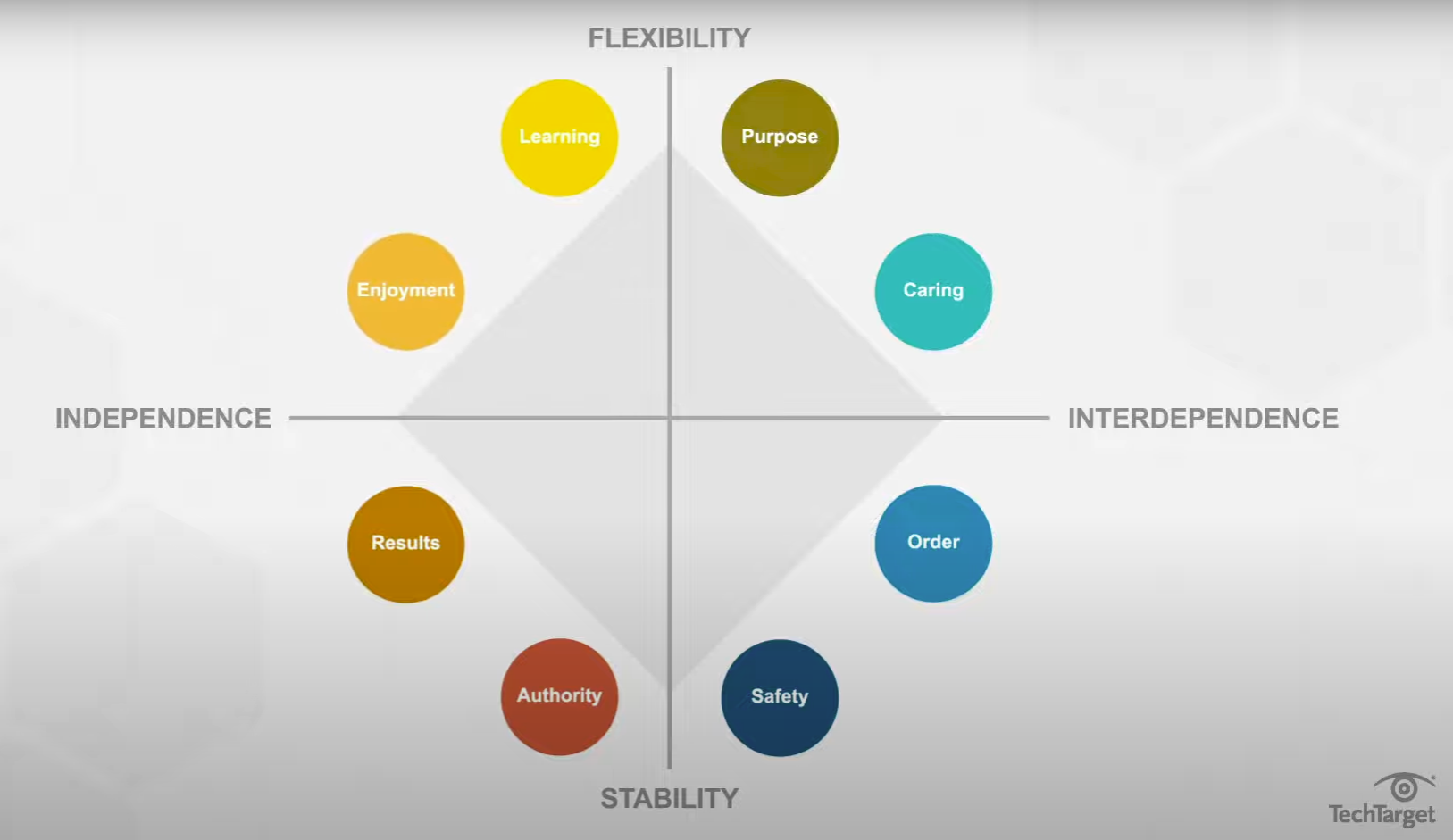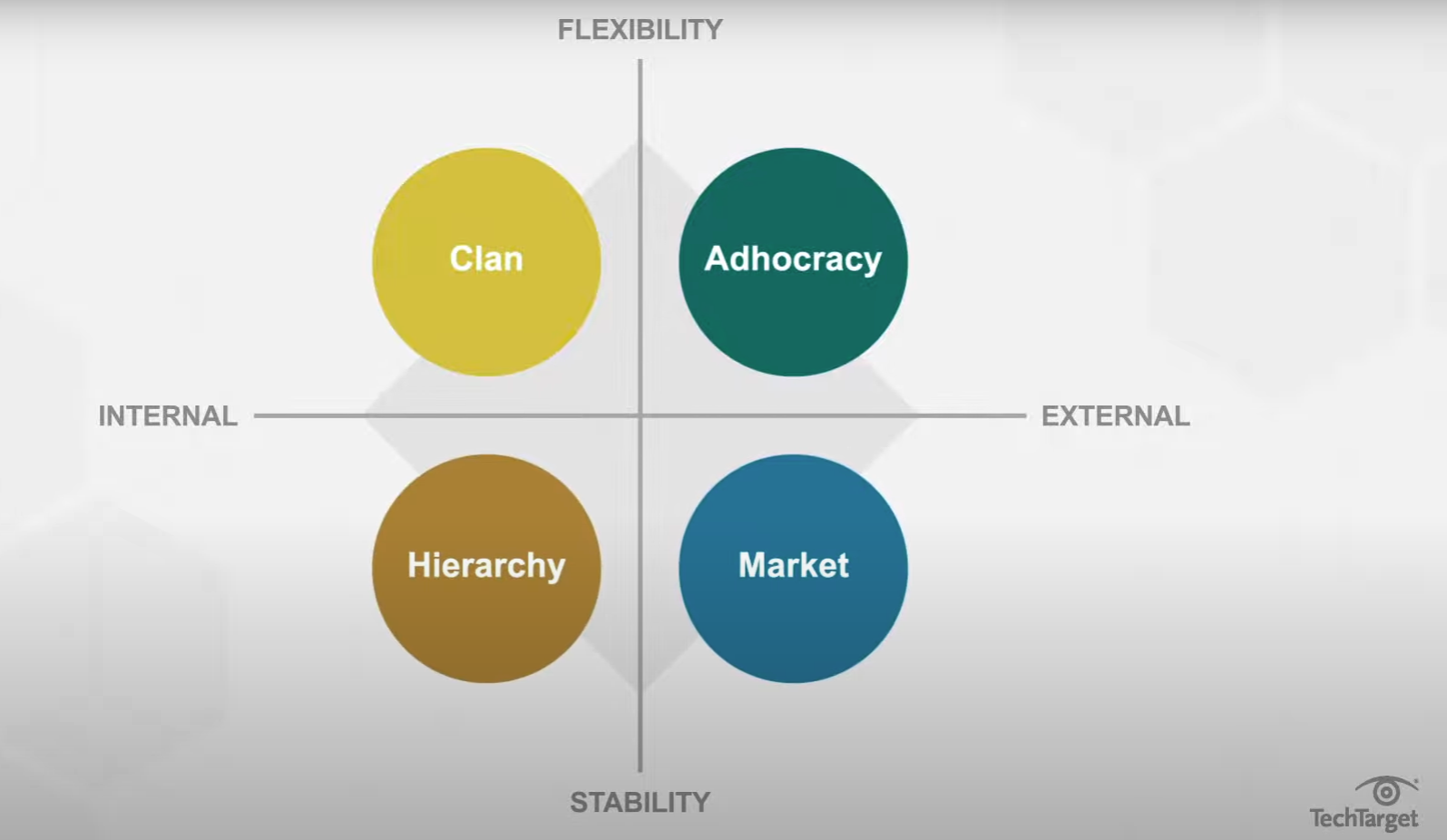8. Organizational Culture¶
Chapter 8: Organizational Culture 1¶
- Organizational culture refers to a system of shared assumptions, values, and beliefs that show people what is appropriate and inappropriate behavior.
- Company success could be attributed to an organizational culture that was decisive, customer-oriented, empowering, and people-oriented.
- The culture of the organization is closely linked to organizational design. For instance, a culture that empowers employees to make decisions could prove extremely resistant to a centralized organizational design, hampering the manager’s ability to enact such a design.
- Researchers found a relationship between organizational cultures and company performance, with respect to success indicators such as revenues, sales volume, market share, and stock prices.
- For example, if a company is in the high-tech industry, having a culture that encourages innovativeness and adaptability will support its performance. However, if a company in the same industry has a culture characterized by stability, high respect for tradition, and a strong preference for upholding rules and procedures, the company may suffer because of its culture.
- Culture is a more powerful way of controlling and managing employee behaviors than organizational rules and regulations.
- Levels of Organizational Culture (from deepest (less visible) to surface (most visible)):
- Assumptions: The deepest level of organizational culture. These are the beliefs that are taken for granted by organization members and are difficult to change. They reflect beliefs about human nature and reality.
- Values: The second level of organizational culture. Values are shared principles, standards, and goals. They are what the organization stands for and what it believes in.
- Artifacts: The most visible level of organizational culture. Artifacts are visible organizational structures and processes. They include the organization’s stories, myths, and legends, as well as its language, logos, and physical structures.
- For example, in an organization, a basic assumption employees and managers share might be that happy employees benefit their organizations. This might be translated into values such as egalitarianism, high-quality relationships, and having fun. The artifacts reflecting such values might be an executive “open door” policy, an office layout that includes open spaces and gathering areas equipped with pool tables, and frequent company picnics.
Dimensions of Culture¶
- Organizational Culture Profile (OCP): culture is represented by seven distinct values.
- Innovative:
- Flexible, adaptable, and experimenting with new ideas.
- These companies are characterized by a flat hierarchy and titles and other status distinctions tend to be downplayed.
- Example: W. L. Gore & Associates, the maker of Gore-Tex fabric and other dental and medical products.
- Other examples: are Genentech and Google.
- Aggressive:
- They value competitiveness and outperforming competitors; by emphasizing this, they often fall short in corporate social responsibility.
- Example: Microsoft.
- In aggressive companies, people may use language such as “we will kill our competition”.
- Outcome-oriented:
- They emphasize achievement, results, and action as important values.
- Example: Best Buy, an electronics retailer.
- Employees are trained and mentored to sell company products effectively, and they learn how much money their department makes every day.
- Outcome-oriented cultures hold employees as well as managers accountable for success and use systems that reward employee and group output.
- In these companies, it is more common to see rewards tied to performance indicators as opposed to seniority or loyalty.
- At the same time, when performance pressures lead to a culture where unethical behaviors become the norm, individuals see their peers as rivals and short-term results are rewarded, the resulting unhealthy work environment serves as a liability.
- Stable:
- They are predictable, rule-oriented, and bureaucratic.
- These cultures prevent quick action and, as a result, may be a misfit to a changing and dynamic environment.
- Public sector institutions may be viewed as stable cultures.
- Example: Kraft Foods.
- These companies with centralized decision-making and rule orientations suffered as a result of the culture-environment mismatch.
- People-oriented:
- They value fairness, supportiveness, and respecting individual rights.
- In these organizations, there is a greater emphasis on and expectation of treating people with respect and dignity.
- New employees in accounting companies found that employees, on average, stayed 14 months longer in companies with people-oriented cultures.
- Example: Starbucks.
- Team-oriented:
- They are collaborative and emphasize cooperation among employees.
- Example: Southwest Airlines.
- In Southwest’s selection process, applicants who are not viewed as team players are not hired as employees.
- In team-oriented organizations, members tend to have more positive relationships with their coworkers and particularly with their managers.
- Detail-oriented:
- They are emphasizing precision and paying attention to details.
- Such a culture gives a competitive advantage to companies in the hospitality industry by helping them differentiate themselves from others.
- Example: Four Seasons Hotels and Resorts; Ritz-Carlton.
- Innovative:
Strength of Culture¶
- A strong culture is one that is shared by organizational members, that is, a culture in which most employees in the organization show consensus regarding the values of the company.
- It is important to realize that a strong culture may act as an asset or a liability for the organization, depending on the types of values that are shared.
- For example, imagine a company with a culture that is strongly outcome-oriented. If this value system matches the organizational environment, the company may perform well and outperform its competitors. This is an asset as long as members are behaving ethically. However, a strong outcome-oriented culture coupled with unethical behaviors and an obsession with quantitative performance indicators may be detrimental to an organization’s effectiveness. Enron is an extreme example of this dysfunctional type of strong culture.
- One limitation of a strong culture is the difficulty of changing it.
- A strong culture may also be a liability during a merger.
Subcultures¶
- In reality, there might be multiple cultures within the organization. For example, people working on the sales floor may experience a different culture from that experienced by people working in the warehouse.
- Cultures that emerge within different departments, branches, or geographic locations are called subcultures.
- Sometimes, a subculture may take the form of a counterculture. Defined as shared values and beliefs that are in direct opposition to the values of the broader organizational culture.
- Countercultures are often shaped around a charismatic leader.
Creating and Maintaining Organizational Culture¶
- An organization’s culture is shaped as the organization faces external and internal challenges and learns how to deal with them.
- Culture creation factors:
- Founder values and preferences:
- Founder values become part of the corporate culture to the degree to which they help the company be successful.
- Industry demands:
- Industry characteristics and demands act as a force to create similarities among organizational cultures.
- For example, despite some differences, many companies in the insurance and banking industries are stable and rule-oriented, many companies in the high-tech industry have innovative cultures, and those in the nonprofit industry may be people-oriented.
- Founder values and preferences:
- Culture maintenance factors:
- Attraction-selection-attrition:
- Attraction: employees are attracted to organizations where they will fit in.
- Selection: organizations select employees who they believe will fit in.
- Attrition: employees who do not fit in leave.
- Because of the ASA process, the company attracts, selects, and retains people who share its core values, whereas those people who are different in core values will be excluded from the organization either during the hiring process or later on through naturally occurring turnover.
- New employee onboarding:
- Onboarding refers to the process through which new employees learn the attitudes, knowledge, skills, and behaviors required to function effectively within an organization.
- Leadership:
- There is a direct correspondence between the leader’s style and an organization’s culture.
- For example, when leaders motivate employees through inspiration, corporate culture tends to be more supportive and people-oriented. When leaders motivate by making rewards contingent on performance, the corporate culture tends to be more performance-oriented and competitive.
- Part of the leader’s influence over culture is through role modeling.
- Reward systems:
- Company culture is shaped by the type of reward systems used in the organization and the kinds of behaviors and outcomes it chooses to reward and punish
- Attraction-selection-attrition:
Signs of Organizational Culture¶
- Mission Statement:
- Some mission statements are written in a way that reflects the values of the organization and its culture, but some are not.
- Some mission statements reflect who the company wants to be as opposed to who they actually are.
- Stories and Language:
- A story can highlight a critical event an organization faced and the organization’s response to it, or a heroic effort of a single employee illustrating the company’s values.
- Companies often have their own acronyms and buzzwords that are clear to them and help set apart organizational insiders from outsiders. In business, this code is known as jargon.
- Physical Layout:
- A company’s building, layout of employee offices, and other workspaces communicate important messages about a company’s culture.
- A company that has an open layout where high-level managers interact with employees may have a culture of team orientation and egalitarianism, whereas a company where most high-level managers have their own floor may indicate a higher level of hierarchy.
- Rules and Policies:
- Companies create rules to determine acceptable and unacceptable behavior and, thus, the rules that exist in a company will signal the type of values it has.
- Policies about issues such as decision-making, human resources, and employee privacy reveal what the company values and emphasizes.
- Rituals:
- Rituals refer to repetitive activities within an organization that have symbolic meaning.
Creating Culture Change¶
- Creating a sense of urgency:
- In successful culture change efforts, leaders communicate with employees and present a case for culture change as the essential element that will lead the company to eventual success.
- Change leaders and other key players:
- Cultural change often follows changes at the highest levels of the organization.
- Sometimes, it is easier to fire and hire new managers than to change the values of existing ones.
- Because of political reasons, self-interest, or habits, managers may create powerful resistance to change efforts. In such cases, replacing these positions with employees and managers giving visible support to the change effort may increase the likelihood that the change effort succeeds.
- Role modeling:
- Role modeling is the process by which employees modify their own beliefs and behaviors to reflect those of the leader.
- Training and communication:
- Well-crafted training programs may be instrumental in bringing about culture change by teaching employees new norms and behavioral styles.
- Change the reward system:
- The criteria with which employees are rewarded and punished have a powerful role in determining the cultural values of an organization.
- Create new stories, symbols, and rituals:
- Continental Airlines is a company that successfully changed its culture to be less bureaucratic and more team-oriented in the 1990s.
- The company burned its 800-page company policy and replaced it with an 80-page booklet.
- Another early action was redecorating waiting areas and repainting all their planes, again symbolizing the new order of things.
Videos 2 3¶
- Types of Organizational Culture (independence, interdependence, flexibility, stability):

- Types of Organizational Culture (internal, external, flexibility, stability):

References¶
-
Carpenter, M., Bauer, T., & Erdogan, B. (2010). Management principles, v. 1.1. https://2012books.lardbucket.org/books/management-principles-v1.1/s12-organizational-culture.html ↩
-
Eye on Tech. (2020, August 28). What is corporate culture? The importance of a positive corporate culture [Video]. YouTube. https://youtu.be/wcLvXLtKQwk ↩
-
Denison Consulting. (2016, August 15). What is organizational culture? [Video]. YouTube.https://youtu.be/4cBN8xH-5Qw ↩